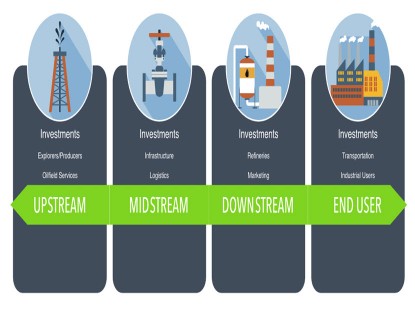Midstream Companies in an Inflationary, Rising Rate Environment
The Portfolio Managers share their insights on capital expenditure spending, fluctuations of natural gas prices, how midstream and MLP companies have historically outperformed during periods of high inflation, and the current investment case for midstream companies.
-
 Ben Cook, CFAPortfolio Manager
Ben Cook, CFAPortfolio Manager -
 L. Joshua Wein, CAIAPortfolio Manager
L. Joshua Wein, CAIAPortfolio Manager
Would you please discuss midstream energy companies’ expected capital expenditure (capex) spending and leverage levels?
Midstream energy company capex spending in 2023 is projected to total $33 billion, which would represent an increase from the 2022 level of $26 billion. However, 2023 capex spending levels will likely trail the sector’s 5-year average (between 2017-2021) annual level of nearly $40 billion as modest spending plans continue to reflect allocations toward other priorities including further debt reduction and rising shareholder payout.
We believe midstream companies have responded to the investment community’s call for improved financial flexibility. During 2022, average leverage levels across the sector declined by roughly 0.6x on a debt to EBITDA basis, falling from a level of 4.4x at year end 2021 to estimated level of 3.8x at year end 2022.
How have the fluctuations in the price of natural gas affected midstream companies?
Natural gas price volatility has had an impact on seasonal natural gas pricing spreads. In fact, the difference between winter 2023 pricing and summer 2023 pricing for natural gas has widened to a level not seen since 2006, well above the spread’s historical 10-year average. Midstream companies that operate gas storage assets are able to buy natural gas at a lower price in the summer and sell it for a higher price in the winter, thereby capturing this seasonal pricing spread. In the Hennessy Midstream Fund, companies that operate gas storage facilities include Energy Transfer, Kinder Morgan, ONEOK, and Williams Companies.
One thing to keep in mind is that there is now a more intense use of gas storage facilities in the U.S. Although U.S. natural gas demand has risen 40% since 2015, gas storage capacity has only increased 1% which means operators of storage facilities have greater potential to capture seasonal spreads amidst seasonal pricing volatility.
As a reminder, in managing the Midstream Fund, we prefer companies with long-term contracts to minimize fluctuations in their overall cash flow streams due to day-to-day commodity price volatility.
Midstream and MLP companies have historically outperformed during periods of high inflation. What is the correlation between inflation and energy prices?
Historically, energy prices and inflation have been highly correlated. Although crude oil and liquids typically have about a 7% direct contribution to the consumer price index (CPI), the indirect input would be higher considering that many parts of CPI are generally affected by energy prices. Therefore, during times of elevated oil prices, many energy companies thrive and in general, midstream companies’ financial results are better. This trend bears out in the correlation between the Alerian MLP Index performance and CPI: Over the past 20 years ended 12/31/22, in the years when CPI is higher than 3%, the correlation has been 0.9.
What is the investment case for midstream companies?
There are several attractive attributes about midstream companies:
1. Attractive yield. Midstream C-Corps’ current average yield as of 2/28/23 was 6.4%, while the average yield of midstream master limited partnerships (MLPs) was 7.9%.1
2. Favorable dividend/distribution growth. Distributions continue to represent a meaningful component of total shareholder/unitholder return. Since the year 2000, the historical midstream sector annual cash payout growth has averaged 5%. During 2023, we anticipate this trend to continue with cash payout growth projected to rise 5%.
3. Well-funded cash payouts could lead to further increases in the future. These distributions have been well covered in terms of the amount of cash generated by companies. For example, in 2019, the average distribution coverage in the midstream sector was 1.6x, so every $1 in payout per share/unit was covered by $1.60 distributable cash per share/unit. In 2022, the coverage was 2x, meaning that companies on average covered their distribution by 100%, generating $2 in distributable cash for every $1 paid to investors. Over the next 5 years, the average distribution coverage is forecasted to be 1.8 to 1.9x.1
4. Lower leverage over time. Midstream sector leverage (debt to EBITDA) was approximately 3.8x at year end 2022, while the 5-year average (2017-2021) has been about 4.6x. This figure is anticipated to decline to 3.2x by 2027.1
5. Attractive valuation. As of 2/28/23, C-Corps were trading at 9.0x EBITDA, below their 5-year historical average of 10.1x. Midstream MLPs were trading at 7.7x EBITDA, lower than the year average of 8.5x as of the same period.1
With a higher-quality balance sheet, consistent distribution growth, and a higher distribution coverage, we believe the case exists for higher prices in midstream equities.
- In this article:
- Energy
- Midstream Fund
1 Source: Wells Fargo Securities
You might also like
-
 Investment Idea
Investment IdeaDefining the Energy "Value Chain"
 Ben Cook, CFAPortfolio ManagerRead the Investment Idea
Ben Cook, CFAPortfolio ManagerRead the Investment IdeaEnergy is a large and complex sector. The sector’s broad sub-industries can be divided into a “value chain,” each segment of which has different characteristics and offers different investment opportunities.
-
 Portfolio Perspective
Portfolio Perspective
Energy Transition FundEnergy - Attractively Valued Sector with Higher Free Cash Flow Yields
 L. Joshua Wein, CAIAPortfolio Manager
L. Joshua Wein, CAIAPortfolio Manager Ben Cook, CFAPortfolio ManagerRead the Commentary
Ben Cook, CFAPortfolio ManagerRead the CommentaryIn the following commentary, Portfolio Manager Ben Cook and Josh Wein discuss the Fund’s disciplined process throughout the volatility driven by tariff uncertainty and geopolitical developments.
-
 Portfolio Perspective
Portfolio Perspective
Gas Utility FundNatural Gas: Essential to Reliable Power
 Ryan C. Kelley, CFAChief Investment Officer and Portfolio Manager
Ryan C. Kelley, CFAChief Investment Officer and Portfolio Manager L. Joshua Wein, CAIAPortfolio ManagerRead the Commentary
L. Joshua Wein, CAIAPortfolio ManagerRead the CommentaryUtilities have delivered strong returns in 2025, fueled by demand trends, earnings growth and their defensive nature, positioning natural gas utilities as a compelling opportunity amid market uncertainty.
